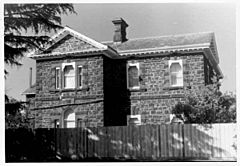D'Estaville facts for kids
Quick facts for kids d'Estaville |
|
|---|---|

d'Estaville, pictured in 1984.
|
|
| General information | |
| Status | Complete |
| Type | House / Mansion |
| Architectural style |
|
| Location | Kew, Melbourne, Victoria, Australia |
| Completed | 1859 |
| Client | Sir William Foster Stawell |
| Technical details | |
| Material | Bluestone |
| Design and construction | |
| Architecture firm | Knight & Kerr |
| Official name: d'Estaville' | |
| Type: | Heritage place |
| Designated: | 9 October 1974 |
| Reference #: | 616 |
| Category: | Residential buildings (private) |
d'Estaville is a grand, historic house located in Kew, a suburb of Melbourne, Australia. It was built using a strong, dark grey stone called bluestone. The house was designed in the Italianate style, which was popular in the 1800s.
Completed in 1859, d'Estaville was created by famous architects Knight & Kerr. They also designed the Victorian Parliament House. The house was built for Sir William Foster Stawell, who was a very important politician and the Chief Justice of Victoria for many years. d'Estaville is special because it's a rare example of the Italianate style and the only house Knight & Kerr ever designed.
In 1888, Sir Stawell's health was not good. He decided to sell off parts of his large property, which was then called the d'Estaville Estate. Later, in 1904, the rest of the land and the house were sold to new owners.
Contents
What Makes d'Estaville Special?
d'Estaville stands out because it's one of the few mansions in Melbourne built almost entirely from bluestone. This gives it a unique, strong look. The house has two floors and is built in an Anglo-Italian villa style. This means it combines English and Italian architectural ideas.
Italianate Style and Design
The Italianate style was part of a bigger art movement called Romanticism. This style aimed for more freedom and interesting shapes in buildings. d'Estaville shows this with its slightly uneven shape and thick bluestone walls.
The house has beautiful stone details. The corners and windows are made from bluestone blocks with special rough-cut centers. These are called "rock-faced quoins." The rest of the bluestone walls are made of neatly stacked, squared stones.
Roof and Windows
The roof of d'Estaville is gently sloped and covered with slate tiles. It has decorative features called "cornices" with trapezoid-shaped brackets. You can also see diamond and eight-pointed star shapes cut into the eaves (the part of the roof that hangs over the walls).
Most windows are "double-hung," meaning they slide up and down. They have curved arches above them. However, there are a few special windows. One is a large "Serlian window" on the west side, which has three parts. Above it is a similar three-part window. The service areas of the house have narrower windows divided into six smaller panes.
One common feature of Italianate homes is a small tower called a "cupola." Interestingly, d'Estaville does not have one. Over the years, different owners have added their own changes and extensions to the house.
Why d'Estaville is Important
d'Estaville is a very important historical building. It's significant because of its connection to Sir William Foster Stawell, a key figure in early Victoria. It's also important because it was designed by the famous architects Knight & Kerr.
The house is known for its amazing bluestone work, which shows off the skill of the builders. It's the only house that Knight & Kerr are known to have designed. This grand home also shows how important Sir Stawell was in the early days of the colony. It also highlights the beautiful design and style of the Classical Revival period.
Because of its historical and architectural value, d'Estaville was added to the Victorian Heritage Register in 1974. This means it is protected as a significant part of Victoria's history.

